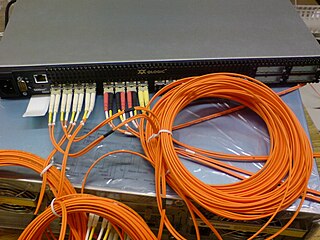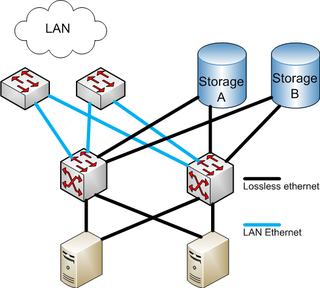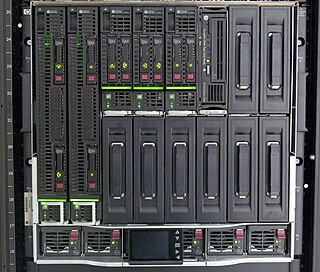Internet Small Computer Systems Interface or iSCSI is an Internet Protocol-based storage networking standard for linking data storage facilities. iSCSI provides block-level access to storage devices by carrying SCSI commands over a TCP/IP network. iSCSI facilitates data transfers over intranets and to manage storage over long distances. It can be used to transmit data over local area networks (LANs), wide area networks (WANs), or the Internet and can enable location-independent data storage and retrieval.
Fibre Channel (FC) is a high-speed data transfer protocol providing in-order, lossless delivery of raw block data. Fibre Channel is primarily used to connect computer data storage to servers in storage area networks (SAN) in commercial data centers.

In computer hardware, a host controller, host adapter, or host bus adapter (HBA), connects a computer, which acts as the host system, to other network and storage devices. The terms are primarily used to refer to devices for connecting SCSI, Fibre Channel and SATA devices. Devices for connecting to IDE, Ethernet, FireWire, USB and other systems may also be called host adapters.
A World Wide Name (WWN) or World Wide Identifier (WWID) is a unique identifier used in storage technologies including Fibre Channel, Parallel ATA, Serial ATA, NVM Express, SCSI and Serial Attached SCSI (SAS).
Xserve RAID was a attachment mass-storage server that was offered by Apple Inc.

In the computer storage field, a Fibre Channel switch is a network switch compatible with the Fibre Channel (FC) protocol. It allows the creation of a Fibre Channel fabric, that is the core component of a storage area network (SAN). The fabric is a network of Fibre Channel devices which allows many-to-many communication, device name lookup, security, and redundancy. FC switches implement zoning, a mechanism that disables unwanted traffic between certain fabric nodes.
FICON is the IBM proprietary name for the ANSI FC-SB-3 Single-Byte Command Code Sets-3 Mapping Protocol for Fibre Channel (FC) protocol. It is a FC layer 4 protocol used to map both IBM's antecedent channel-to-control-unit cabling infrastructure and protocol onto standard FC services and infrastructure. The topology is fabric utilizing FC switches or directors. Valid rates include 1, 2, 4, 8 and 16 Gigabit per second data rates at distances up to 100 km.
In computing, the proposed Internet Storage Name Service (iSNS) protocol allows automated discovery, management and configuration of iSCSI and Fibre Channel devices on a TCP/IP network.

The arbitrated loop, also known as FC-AL, is a Fibre Channel topology in which devices are connected in a one-way loop fashion in a ring topology. Historically it was a lower-cost alternative to a fabric topology. It allowed connection of many servers and computer storage devices without using then very costly Fibre Channel switches. The cost of the switches dropped considerably, so by 2007, FC-AL had become rare in server-to-storage communication. It is however still common within storage systems.
Brocade is an American technology company specializing in storage networking products, now a subsidiary of Broadcom Inc. The company is known for its Fibre Channel storage networking products and technology. Prior to the acquisition, the company expanded into adjacent markets including a wide range of IP/Ethernet hardware and software products. Offerings included routers and network switches for data center, campus and carrier environments, IP storage network fabrics; Network Functions Virtualization (NFV) and software-defined networking (SDN) markets such as a commercial edition of the OpenDaylight Project controller; and network management software that spans physical and virtual devices.
In Fibre Channel protocol, a registered state change notification (RSCN) is a Fibre Channel fabric's notification sent to all specified nodes in case of any major fabric changes. This allows nodes to immediately gain knowledge about the fabric and react accordingly.

The IBM BladeCenter was IBM's blade server architecture, until it was replaced by Flex System in 2012. The x86 division was later sold to Lenovo in 2014.
Fibre Channel Protocol (FCP) is the SCSI interface protocol utilising an underlying Fibre Channel connection. The Fibre Channel standards define a high-speed data transfer mechanism that can be used to connect workstations, mainframes, supercomputers, storage devices and displays. FCP addresses the need for very fast transfers of large volumes of information and could relieve system manufacturers from the burden of supporting a variety of channels and networks, as it provides one standard for networking, storage and data transfer. Some Fibre Channel characteristics are:
NX-OS is a network operating system for the Nexus-series Ethernet switches and MDS-series Fibre Channel storage area network switches made by Cisco Systems. It evolved from the Cisco operating system SAN-OS, originally developed for its MDS switches.

Fibre Channel over Ethernet (FCoE) is a computer network technology that encapsulates Fibre Channel frames over Ethernet networks. This allows Fibre Channel to use 10 Gigabit Ethernet networks while preserving the Fibre Channel protocol. The specification was part of the International Committee for Information Technology Standards T11 FC-BB-5 standard published in 2009.

A storage area network (SAN) or storage network is a computer network which provides access to consolidated, block-level data storage. SANs are primarily used to access data storage devices, such as disk arrays and tape libraries from servers so that the devices appear to the operating system as direct-attached storage. A SAN typically is a dedicated network of storage devices not accessible through the local area network (LAN).

BladeSystem is a line of blade server machines from Hewlett Packard Enterprise that was introduced in June 2006.
In Sun Microsystems software, STMSBOOT is the command line utility for managing Solaris Multiplexed I/O. This was known as StorEDGE Traffic Manager (STMS) and is now referred to as MPxIO.
Adaptable Modular Storage 2000 is the brand name of Hitachi Data Systems mid-range storage platforms.

The Dell blade server products are built around their M1000e enclosure that can hold their server blades, an embedded EqualLogic iSCSI storage area network and I/O modules including Ethernet, Fibre Channel and InfiniBand switches.







